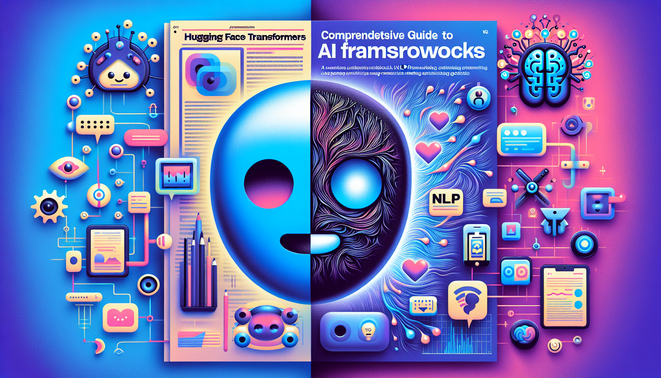Physical Address
304 North Cardinal St.
Dorchester Center, MA 02124
Physical Address
304 North Cardinal St.
Dorchester Center, MA 02124

Comprehensive Guide to AI Tools: Hugging Face Transformers vs. OpenAI Frameworks
Explore the powerful capabilities and unique offerings of Hugging Face Transformers and OpenAI frameworks in AI development, with detailed insights into architecture, implementations, and best practices for informed decision-making.
Meta Summary
Discover the capabilities and applications of Hugging Face Transformers and OpenAI frameworks in AI development. Gain insights into their architecture, implementation strategies, and real-world use cases, and explore best practices for integration into DevOps.
Introduction to AI Tools
AI tools are at the forefront of modern technology, revolutionizing development by automating tasks, providing precise predictions, and enhancing decision-making processes. This article aims to shed light on the vital role of AI tools in today’s tech landscape, focusing on the distinct features of Hugging Face Transformers and OpenAI frameworks.
Learning Objectives:
Comprehend the role of AI tools in contemporary development.
Identify the distinguishing features of AI frameworks.
AI frameworks are designed to simplify AI model creation and training. They support a wide range of tasks such as natural language processing and computer vision, becoming indispensable tools in tech industries.
Overview of Hugging Face Transformers
Hugging Face Transformers have made significant strides in natural language processing (NLP), known for their sophisticated models and integrations.
Learning Objectives:
Identify core features of Hugging Face Transformers.
Explore available integrations and models.
Hugging Face provides a plethora of pre-trained models for tasks like text generation and sentiment analysis. Their ability to comprehend human language makes them particularly effective in NLP applications.
Case Study: Text Generation for Customer Service Bots
Through text generation models, Hugging Face has enabled companies to automate customer interactions, enhancing satisfaction and reducing costs.
Best Practices:
Document your model training and deployment.
Employ version control for managing iterations.
Regularly update models to improve accuracy.
Pitfalls:
Ignoring model performance post-deployment.
Overfitting models without validation.
Overlooking cloud resource costs.
Exercise:
Build a sentiment analysis model using Hugging Face.
Exploring OpenAI Frameworks
OpenAI frameworks are acclaimed for their machine learning capabilities, particularly in creative content generation.
Learning Objectives:
Detail the functionalities of OpenAI frameworks.
Evaluate the unique offerings of OpenAI in AI development.
OpenAI frameworks, with their user-friendly APIs, make it easy to integrate AI solutions, enabling rapid deployment.
Case Study: Generating Creative Content for Marketing Campaigns
OpenAI’s powerful language models are crucial in crafting engaging marketing content and strategies.
Exercise:
Use OpenAI to create a text summarization tool.
Architecture Comparisons Between Hugging Face and OpenAI
Understanding the architectural differences is crucial for selecting the appropriate framework.
Learning Objectives:
Analyze architecture differences.
Compare deployment options.
Hugging Face uses transformer architecture, ideal for NLP tasks, while OpenAI scales to handle broader applications.
Visual Aid Suggestion:
Create a comparison chart for model architectures of Hugging Face and OpenAI.
Implementation Strategies
Strategizing model implementation is essential for success. Explore how to execute models with Hugging Face and OpenAI.
Learning Objectives:
Execute model implementation with Hugging Face and OpenAI.
Evaluate training and fine-tuning ease.
Choosing the right framework and data for model training and fine-tuning is crucial.
Exercises:
Develop a sentiment analysis model with Hugging Face.
Create a text summarization tool with OpenAI.
DevOps and Deployment Considerations
Integrating AI models into DevOps pipelines ensures efficient scaling and maintenance.
Learning Objectives:
Identify best practices for DevOps integration.
Compare deployment scalability and maintenance.
In DevOps, prioritize integration and deployment, automate testing, and use containerization.
Exercises:
Containerize a Hugging Face model with Docker.
Deploy an OpenAI model on a cloud platform.
Visual Aid Suggestion:
Design a deployment flow diagram for cloud integration.
Performance Benchmarks
Performance metrics are vital for understanding resource usage and speed trade-offs.
Learning Objectives:
Review performance metrics.
Understand trade-offs in performance.
Hugging Face offers a balance in performance, while OpenAI focuses on complex task capability.
Real-world Use Cases
Real-world applications of AI models illustrate their business impact.
Learning Objectives:
Identify use cases for Hugging Face and OpenAI.
Demonstrate business impact of AI models.
Hugging Face is prevalent in customer service automation, while OpenAI has transformed marketing content creation.
Conclusion
Both Hugging Face Transformers and OpenAI frameworks provide powerful AI development tools. Understanding their features allows businesses to drive innovation effectively.
Learning Objectives:
Recap essential analysis points.
Encourage further AI tool exploration and experimentation.
Visual Aids Suggestions
Comparison chart of model architectures for Hugging Face and OpenAI.
Deployment flow diagram for integrating AI models in cloud environments.
Key Takeaways
AI tools offer significant development benefits through automation and decision-making enhancement.
Hugging Face specializes in NLP, while OpenAI’s versatility extends to multiple domains.
Understanding framework differences aids in task-specific model selection.
Implementing best practices in DevOps ensures efficient model deployment and scaling.
Glossary
AI Framework: A library designed to simplify AI model training.
Transformers: Effective NLP model architecture.
DevOps: Practices blending development and IT operations.
Knowledge Check
What is the primary use case of Hugging Face Transformers?
A) Image recognition
B) Natural language processing
C) Data analysis
D) Financial forecasting
How does OpenAI’s API facilitate development?
Short Answer: OpenAI’s API provides seamless integration with user-friendly interfaces, enabling rapid AI-driven solution deployment.
Further Reading
Hugging Face Transformers Documentation
OpenAI Introduction
Comparing AI Frameworks: Hugging Face vs. OpenAI